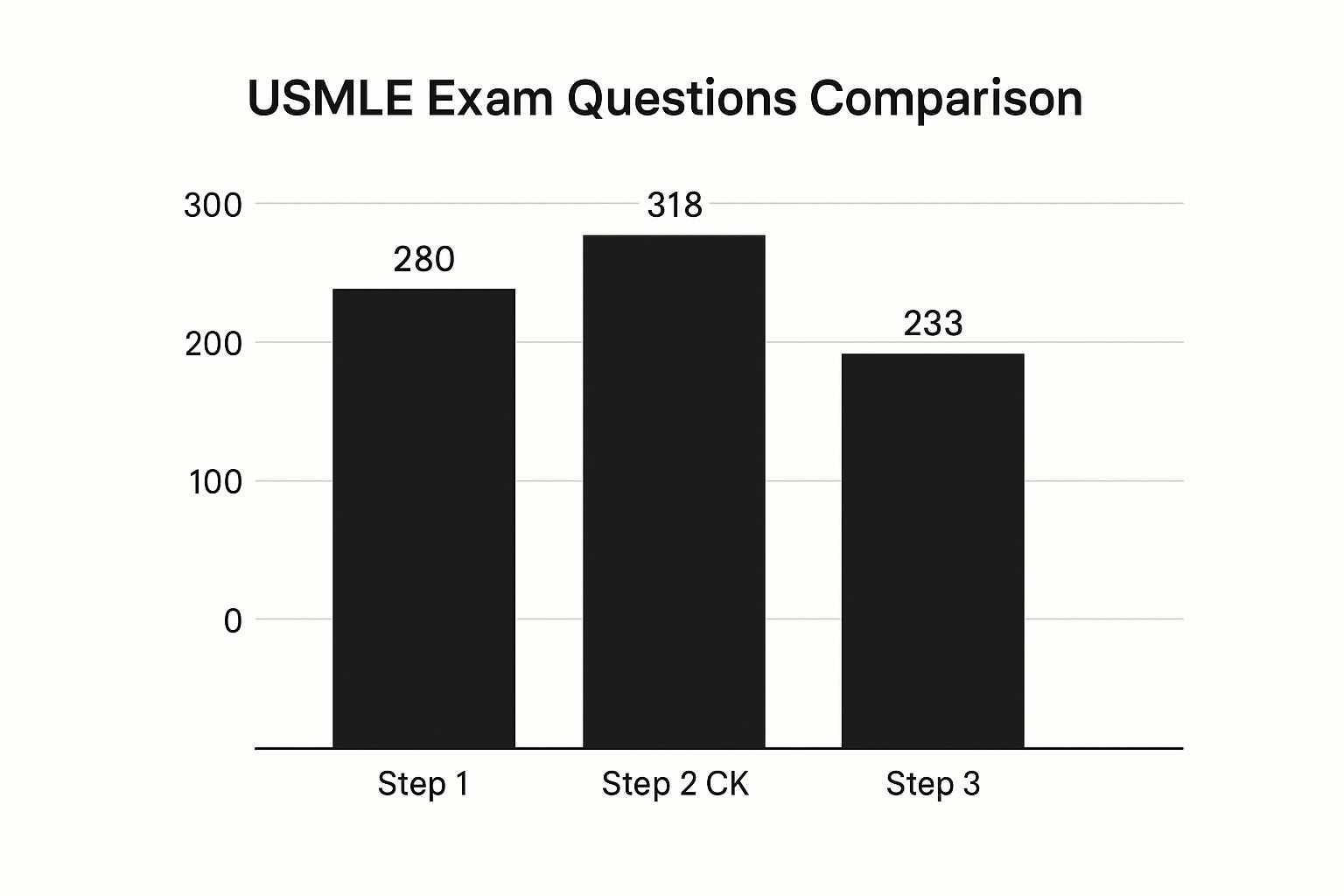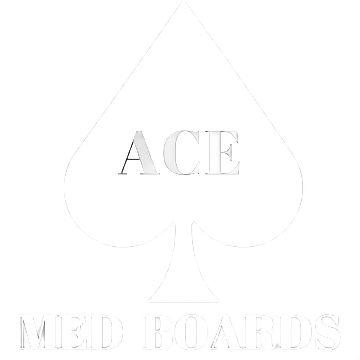Let's be honest: the USMLE isn't just another test. It’s a massive undertaking designed to see if you can actually apply what you've learned in a real clinical setting. That's why the first, most critical step in your prep is getting to know the official USMLE content outline. Think of it as your road map—it details every single subject and competency you'll be tested on.
Decoding the USMLE Exam Blueprint
The USMLE journey is designed to be a progressive evaluation. Step 1 lays the groundwork with foundational sciences, and by Step 3, the focus shifts to what it takes to practice independently. Following this blueprint is the key to moving beyond rote memorization and toward the integrated, conceptual thinking the exams demand. When you're facing an exam of this size, you need more than just content knowledge; check out these 5 Study Tips to Pass Any Test for some broader strategies that can help.
The official outline isn't static, either. It’s constantly updated to keep pace with evolving medical knowledge and clinical priorities, making sure it stays relevant to modern patient care. This framework covers everything from normal body processes and disease mechanisms to health promotion. You can get a deeper look into how the exam is developed by reading the annual USMLE report.
In the following sections, we’ll break down exactly what you can expect from each Step.
Analyzing the USMLE Step 1 Content Outline
Step 1 is all about your command of the foundational sciences that underpin everything you'll do in medicine. Even though it's now pass/fail, a deep understanding of the USMLE content outline for this exam is non-negotiable. Why? Because this material is the bedrock for the scored Step 2 CK and Step 3 exams you'll face later.
The exam is smartly designed to test your ability to integrate concepts across different disciplines and organ systems, not just regurgitate isolated facts.
The official USMLE site provides a fantastic visual breakdown of what to expect, as you can see below.

This chart is your roadmap, clarifying the exam's structure and the weight given to different areas. Since the big shift to a pass/fail system on January 26, 2022, we've seen a slight change in outcomes. Pass rates for first-time US/Canadian test-takers, which used to hover between 95-97%, have settled into the 90-93% range.
To really get ahead, you need a solid game plan from day one. If you're looking for a comprehensive strategy, be sure to check out our detailed guide on how to study for USMLE Step 1.
USMLE Step 1 Content Specification by Discipline and System
To give you a clearer picture, I've broken down the content specifications into a simple table. This shows you the approximate percentage of questions you can expect from each scientific discipline and organ system. Use this to guide where you spend your precious study hours.
| Discipline/System | Approximate Percentage of Exam |
|---|---|
| Scientific Disciplines | |
| Pathology | 44–52% |
| Physiology | 25–35% |
| Pharmacology | 15–22% |
| Biochemistry & Nutrition | 14–24% |
| Microbiology | 10–15% |
| Immunology | 6–11% |
| Gross Anatomy & Embryology | 11–15% |
| Histology & Cell Biology | 8–13% |
| Behavioral Sciences | 8–13% |
| Genetics | 5–9% |
| Organ Systems (Normal & Abnormal Processes) | |
| General Principles | 13–17% |
| Behavioral Health & Nervous Systems/Special Senses | 9–13% |
| Musculoskeletal System/Skin & Subcutaneous Tissue | 6–10% |
| Cardiovascular System | 6–10% |
| Respiratory & Renal/Urinary Systems | 9–13% |
| Gastrointestinal System | 5–9% |
| Reproductive & Endocrine Systems | 9–13% |
| Multisystem Processes & Disorders | 4–6% |
| Immune System/Blood & Lymphoreticular System/Biostat | 9-13% |
As you can see, concepts like Pathology and Physiology form the absolute core of the exam. However, don't sleep on the integrated nature of the questions. A single question might pull from pharmacology, physiology, and pathology all at once, which is why a system-based approach to studying often yields the best results.
Mastering the USMLE Step 2 CK Content Outline
When you hit Step 2 Clinical Knowledge (CK), the game changes. You're moving beyond the foundational sciences of Step 1 and into the world of practical, real-world clinical application. To succeed here, you have to get comfortable with the two-dimensional usmle content outline that really just mirrors what a physician does every day.
This exam structure is designed to test you on two fronts simultaneously: Physician Tasks/Competencies (like Patient Care) and Clinical Science Disciplines (think Internal Medicine or Surgery). Unlike Step 1, every single question throws you into a clinical scenario where you need to nail the diagnosis and management. The exam still gives you a numeric score, and while pass rates are high—around 98% for first-timers from U.S. M.D. programs—the standards are tough. In fact, the minimum passing score was recently bumped from 209 to 214. For more details, you can dig into the performance data on the official site.
Getting the hang of these case-based questions is absolutely critical. If you're looking for a deep dive into study strategies, we've put together a complete guide on how to study for Step 2 CK.
A Look at the USMLE Step 3 Content Outline
Alright, you've made it to the final boss: USMLE Step 3. This isn't just another exam; it's the final gateway to practicing medicine without supervision. The entire test is designed to see if you're truly ready for that responsibility.
Step 3 has a pretty unique two-day structure that sets it apart. The first day, known as Foundations of Independent Practice (FIP), is a marathon of multiple-choice questions. Think of it as a comprehensive check of all the foundational knowledge you need to have on instant recall.
Day two shifts gears to Advanced Clinical Medicine (ACM). Here, you'll face more MCQs, but also the infamous Computer-based Case Simulations (CCS). These simulations are where the rubber really meets the road, testing you on six core Physician Tasks like 'Obtaining History and Performing Physical Exam' and 'Diagnosis and Management'.
Let's break down the FIP portion first, since that's your day-one challenge. The official content outline shows you exactly what they're looking for.

As you can see, having a rock-solid foundation is non-negotiable. This is reflected in the pass rates, which can vary quite a bit depending on a test-taker's background and preparation. To make sure you're ready for both the FIP and CCS components, check out our guide on how to study for USMLE Step 3. A smart, structured approach is your best defense against the performance gaps often seen on this final, crucial exam.
Integrating Key Physician Competencies
The USMLE is more than a test of pure medical knowledge. While knowing the science is foundational, the exams are designed to see if you can think and act like a competent physician. This means they weave in a core set of professional skills—or competencies—across all three Steps.
You won't find a separate section labeled "Professionalism." Instead, these skills are baked directly into the clinical vignettes. A question that seems to be about diagnosing a cardiac issue might also be subtly testing your ability to deliver difficult news or handle an ethical dilemma.
Success on the USMLE requires developing holistic clinical reasoning skills. Recognizing how questions test multiple competencies at once is key to moving beyond simple memorization and truly preparing for clinical practice.
Think of it this way: the USMLE is trying to figure out if you're ready for the real world of patient care, where every interaction involves more than just a diagnosis.
Here are the main competencies that will be layered into the questions you face:
- Medical Knowledge and Patient Care: This is the bedrock. It’s your ability to take foundational and clinical science and apply it to diagnose, treat, and manage real patient problems.
- Interpersonal and Communication Skills: This goes beyond just talking. It’s about reading a patient’s body language, interpreting non-verbal cues, or explaining a complex diagnosis with genuine empathy.
- Professionalism: This competency is all about your ethical compass. It tests your judgment in tricky situations and your commitment to maintaining professional conduct, even under pressure.
10. The USMLE Content Crosswalk by Topic

One of the biggest mistakes I see students make is studying for each USMLE Step in a vacuum. They treat Step 1, Step 2 CK, and Step 3 as completely separate exams, forgetting that the USMLE is designed as a continuous assessment of a physician's journey. The concepts don't just disappear; they evolve.
Think of this section as your personal "content crosswalk." It's a quick-lookup guide designed to show you exactly how a single medical topic, like Myocardial Infarction, transforms from a basic science question on Step 1 to a complex management scenario on Step 3.
Understanding this progression is a game-changer. It helps you build a truly integrated knowledge base, connecting the "why" from Step 1 with the "how" of Steps 2 and 3.
To make this crystal clear, let's look at how the exam's focus shifts for a single topic across the board:
Step 1: The questions will hammer the foundational science. For an MI, you'll be grilled on the underlying pathophysiology, the cellular mechanisms of ischemia, and the relevant pharmacology of thrombolytics. It's all about the building blocks.
Step 2 CK: Now, the focus pivots to clinical application. You'll be expected to interpret an EKG, diagnose the specific type of MI, and outline the acute management protocol in an emergency setting. This is about being a competent clerkship-level student.
Step 3: The questions get even more complex, testing your ability to function as an independent practitioner. You'll face scenarios involving long-term patient management post-MI, dealing with complications like heart failure or arrhythmias, and navigating patient counseling.
This cross-referencing approach is incredibly powerful. It helps you solidify your understanding, identify specific knowledge gaps, and see the big picture of how medicine is practiced—and tested.
USMLE Content Crosswalk by Topic
Here’s a practical table to show you how this looks for a few high-yield topics. Use it to reframe your thinking as you move through your USMLE prep, always asking yourself, "How would this be tested at the next level?"
| Medical Topic | Step 1 Focus (Foundational Science) | Step 2 CK Focus (Clinical Diagnosis & Management) | Step 3 Focus (Independent Practice & Complications) |
|---|---|---|---|
| Diabetes Mellitus | Insulin signaling pathways, glucose metabolism, histology of the pancreas, mechanism of action of metformin. | Diagnosing Type 2 DM with A1c, initial management with lifestyle and oral agents, screening for nephropathy. | Managing a patient with DKA in the ICU, adjusting insulin for a patient with renal failure, handling hypoglycemia. |
| Pneumonia | Microbiology of common pathogens (e.g., S. pneumoniae), mechanisms of lung consolidation, pharmacology of antibiotics. | Differentiating typical vs. atypical pneumonia on chest X-ray, choosing the right empiric antibiotic, using the CURB-65 score. | Treating hospital-acquired pneumonia, managing antibiotic resistance, handling complications like empyema or lung abscess. |
| Chronic Kidney Disease | Renal physiology (GFR, filtration), pathology of glomerular diseases, mechanism of loop diuretics. | Staging CKD, managing hypertension and anemia in a CKD patient, interpreting electrolyte abnormalities. | Dosing medications in a patient on dialysis, managing mineral and bone disorder, counseling on renal replacement therapy. |
Seeing concepts laid out like this reinforces the continuity of the exams. By understanding how a topic evolves, you're not just memorizing facts for one test; you're building a durable framework of medical knowledge that will serve you all the way through residency and beyond.
Frequently Asked Questions
When you're staring down the barrel of the USMLE series, it's easy to get bogged down in the details. Let's tackle some of the most common questions that come up about the content outlines and what they mean for your study plan.
First, let's look at how the multiple-choice questions (MCQs) stack up across the different Steps.

As you can see, Step 2 CK packs the most MCQs into its exam day. Step 3, on the other hand, has a lower MCQ count because it introduces Computer-based Case Simulations (CCS), shifting some of the focus to clinical management scenarios.
Even though the number of questions changes from one exam to the next, the standard for passing remains incredibly high. For US graduates, both Step 2 CK and Step 3 consistently have pass rates over 95%. This just goes to show how rigorous the path to licensure is. You can dig deeper into these performance patterns on Wikipedia.
Are you finding it tough to see how the basic sciences from Step 1 connect with the clinical knowledge for Steps 2 and 3? The expert tutors at Ace Med Boards are masters at weaving these concepts together, helping you build the integrated understanding that leads to higher scores and more confidence. Book a free consultation today and let's build a study plan that works for you.

